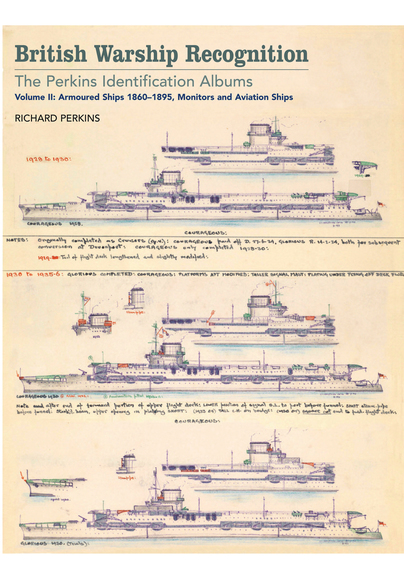
British Warship Recognition: The Perkins Identification Albums. Volume II – Armoured Ships 1860-1895, Monitors and Aviation Ships. By Richard Perkins. Seaforth Publishing, Barnsley, 2016.
Reviewed by David Hobbs
THIS second volume follows the same coloured, large-scale format as the first with beautifully printed reproductions of Perkins’ original drawings and paintings on almost every one of the book’s 223 pages. There are often two ships per page with sketches of funnel shapes and rigging that help the identification of individual ships from photographs of the period.
The armoured ships begin with the 1897 battleship RENOWN on page 22 and then continue through earlier generations to page 154 with the historic WARRIOR and BLACK PRINCE of 1860 as the earliest examples. Some of the ships went on to be depot ships and hulks after their operational service and their appearance during these duties is also faithfully reproduced, giving fascinating illustrations of a largely forgotten era. The section on Monitors runs from page 160 and includes ships that operated off Gallipoli which would have been familiar everyday names to ANZAC soldiers as well as other vessels that operated off the coast of Belgium.
This section also includes the fascinating nineteenth century turret ships, including 3 pages devoted to HMAS CERBERUS with paintings and notes showing the modifications made to the ship throughout its long life. The final section, beginning on page 196, covers aviation ships and includes balloon ships, seaplane carriers, the ships converted into aircraft carriers and the carriers themselves up to and including the 1938 ARK ROYAL. Perkins was forced to stop his life’s work detailing warship appearance when wartime restrictions were imposed in 1939 and so the slightly later ILLUSTRIOUS class is not included.
The Great War seaplane carriers would have been well known to the many Australians who served in the Royal Naval Air Service and there is added interest with the inclusion of HMAS ALBATROSS which merits a page and a single port-side painting.
The larger aircraft carriers have port and starboard side drawings that indicate the detail differences between the ships’ sides. At 45 cm by 35 cm this is a significantly large book to find shelf space for but anyone with an interest in the ships covered in this volume would find it an essential reference work that facilitates individual ship recognition at different periods of their lives.
At a recommended retail price of £60 pounds in the UK it is even more expensive than Volume I but the quality of reproduction has inevitably led to a premium price. Many of the drawings are works of art in their own right and for any enthusiast, especially those of the Navy of the Victorian era, this is an essential reference work that I would heartily recommend; it has certainly taken a valued place in my library. Further volumes covering cruisers and then destroyers are in the course of preparation.



